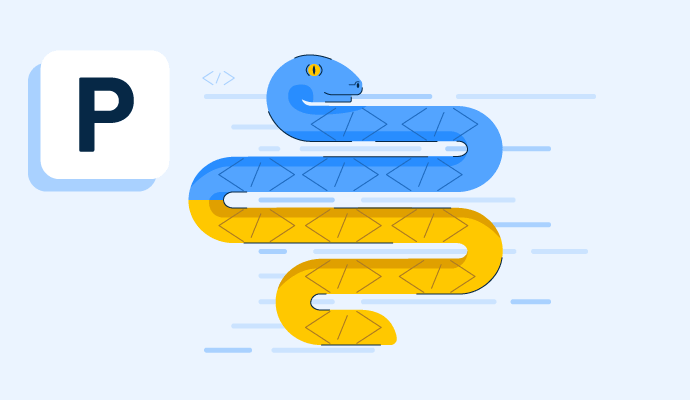What is python?
Python is a simple programming language for novices and experienced developers. It’s a high-level, object-oriented language that’s easy to understand and code.
Python is ideal for prototype development and other ad-hoc tasks. It has modules and packages that support program modularity and code reuse. The Python interpreter and extensive standard library are available on all major platforms. It can run anywhere.
Python's interactive mode makes it easy to test short code snippets. Many developers prefer using software testing tools to determine the quality of software creation and improvement projects. The debugging is easier as there is no compilation step. Many companies use Python in most applications to provide services.
Uses of Python
Below are some notable uses of the Python programming language.
- Usage in web development, data mining, graphical user interface-based desktop programs, game development, and 3D graphics is prevalent.
- Python supports multiple programming paradigms because it integrates with object-oriented programming and structured programming.
- Python has an extensive and robust library for its applications. The standard library helps developers use various ranges of modules available.
- It helps access and customize interfaces of databases like MYSQL, Oracle, Microsoft SQL Server, or PostgreSQL.
- Because it’s a general-purpose programming language, Python simplifies the complex software development process. Python helps analyze data without extra effort or time.
- Many open-source applications of Python frameworks, libraries, and development tools are available without extra costs.
How to learn Python
Python is easy to learn while pursuing data science, machine learning, mobile app development, and website or game development. Below are a few steps for learning Python.
- Read the basics. Understanding the basics lets a novice developer know where to start.
- Download the necessary tools. Since Python is cross-platform, it’s important to experiment with it.
- Learn basic syntax. Doing projects using language syntax and applying knowledge immediately helps the developer remember instructions.
- Get online support. Python has a user-driven community with active online support forums that assist developers with their queries.
- Enroll in advanced courses. Taking a structured course once the basic Python lessons are mastered deepens understanding and skill.
- Participate in the community. Attending events like conferences or workshops develop personal and communal goals.
Benefits of Python
Python has benefits over other programming languages, some of which are outlined below.
- Python has an easy-to-understand syntax compared to other languages.
- Python is a high-level, general-purpose programming paradigm focusing on code readability.
- Python is free. It’s an open-source programming language that anyone can use for free.
- Compatibility is one of the significant barriers any programming language faces. Programmers prefer Python because it works with all platforms.
- Python has a vast library and many frameworks. It features automatic memory, which helps developers be more productive.
- Debugging a Python program is easy. The edit-test-debug cycle is incredibly fast since there is no compilation step.
Python best practices
Python has evolved significantly over the last few decades. The ease of code creation and community support has played a significant role. Below are a few of the best practices to follow while using Python.
- Naming convention: Choosing a meaningful class, variable, or function name improves the readability and uniformity of Python code.
- Structure repository: It’s important to store critical components like a license, a README file, module code, .py files, .txt files, tests, and documentation in a developer’s repository.
- Follow guidelines: Python Enhancement Proposals (PEP8) are development standards that ensure all Python code looks and feels the same.
- Virtual environments: Developers must create a virtual environment for each project to avoid clashes between different library versions.
- Write readable codes: It’s smart to use line breaks and indentation, naming conventions for identifiers, comments, and whitespaces around operators and assignments, maximum line length of up to 79 characters.
-
Correct broken code: Fixing broken code immediately avoids future complications.
Python vs. R
R is a programming language that supports statistical computing and graphics. It supports software facilities for data manipulation, calculation, and graphical display. R environment features a high-performance data storage and handling facility, matrices for array calculations, tools dedicated to data analysis, user-defined recursive functions, loops, conditionals, and input and output facilities.
R lets developers turn messy, unstructured data into a structured format. It has a solid supportive community that is constantly updating and upgrading.
R and Python are both open-source languages and similar in many ways. While Python is a general-purpose programming language, R has its roots in statistical analysis. The primary distinction is in their approach to data science.
Python has a learning curve that is linear and smooth, while with R, it’s easier to run data analysis tasks for novices. Still, the complexity of advanced functionality can make it more difficult to develop expertise. Python is a production-ready language with a readable syntax used in various industry, research, and engineering workflows.
R is a statistical tool used by academics, engineers, and scientists. It needs essential coding experience and an understanding of programming.
Python is a better option for machine learning and large-scale applications, like data analysis within web applications. On the other hand, R is useful for statistical learning; it has unmatched libraries for data exploration and experimentation.
Learn more about database management to make better data-driven decisions and maintain data to seamlessly run development projects.

Sagar Joshi
Sagar Joshi is a former content marketing specialist at G2 in India. He is an engineer with a keen interest in data analytics and cybersecurity. He writes about topics related to them. You can find him reading books, learning a new language, or playing pool in his free time.

